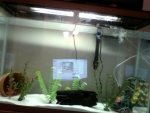carsona246
New member
- Joined
- Sep 16, 2010
- Messages
- 1,073
- Reaction score
- 18
- Points
- 0
- Country
- United States
- Display Name
- Carson
I would just like to add that you should definatly not beat yourself up about losing your axolotl. I've heard of people on this forum using ammonia neutralizer. I still wouldn't ever recommend using it, but I'm not sure if I would totally blame the chemicals you added on the death of your axolotl. Sand is fine as substrate. On to cycling, while it is easier to cycle a tank with no animals in it, if you already have an axolotl on the way I don't see why you couldn't just put the axolotl in an uncycled 45 and just watch the parameters closely. A 45 gallon fish tank is more than enough for one axolotl, so if you just monitor the water every day, and do water changes as needed the tank should cycle on it's own. I would just skip the ammonia neutralizer, as I've read that impedes the cycling process, and I've never heard good things about it.

